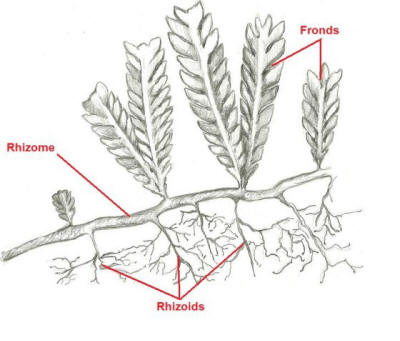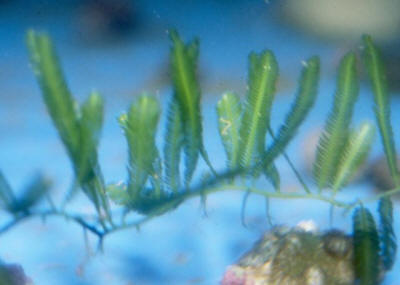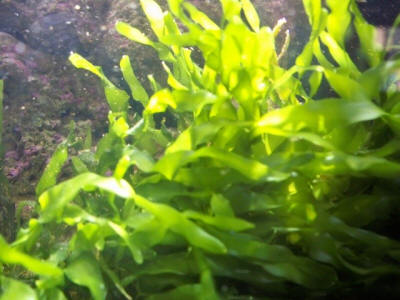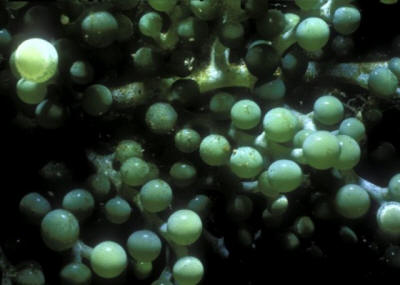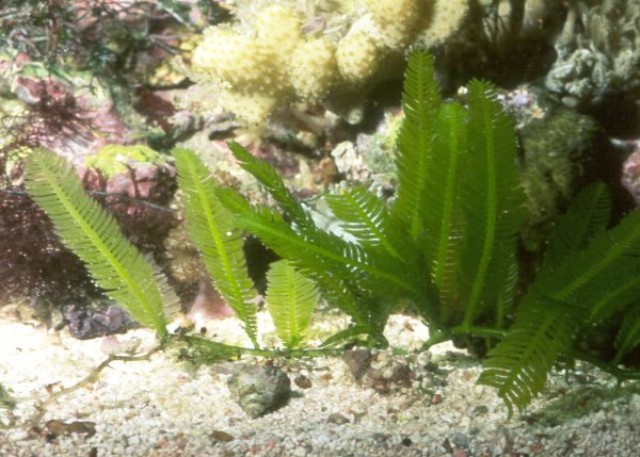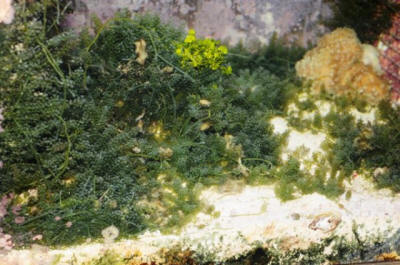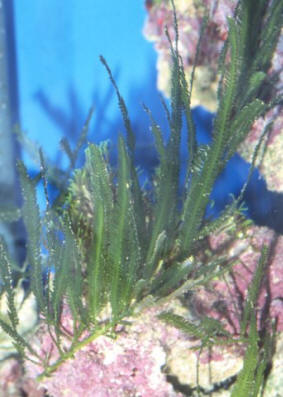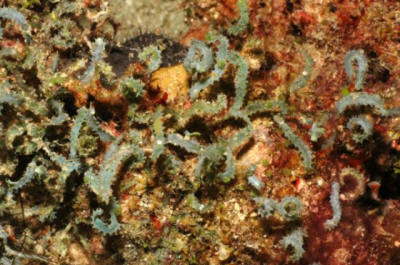By Adam Jenkins © 2009
Caulerpa are fast-growing green
algae with fronds (“leaves”) that come in a variety of shapes. The fronds from
to between 15-30 cm (6-12 inches) in length and are attached to long runners
(“stems”) called rhizomes. Besides simply spreading outwards, Caulerpa
can also propagate themselves vegetatively through sections of rhizome that
break off the parent plant and become established elsewhere.
Caulerpa rhizomes are attached to
the substrate by fine hair-like extensions known as rhizoids. As is the case
with all algae, the similarities between rhizoids and the roots of true
(vascular) plants such as seagrasses are misleading; rhizoids only anchor the
algae in the sediment, and play no role in absorbing mineral nutrients.
Caulerpa, like all algae, absorb the minerals they need from the water via
their leaves.
Caulerpa are found in a variety
of shallow water marine habitats. Substrate types vary from solid rock through
to sand and mud, and Caulerpa can be found in both calm and rough water
areas. Because of their adaptability and the ease with which they can propagate
themselves vegetatively, Caulerpa can be a highly invasive species.
Taxonomy
Caulerpa are members of the
Chlorophyta, or green algae. More specifically, they are members of the order
Bryopsidales, a group that includes some other familiar ornamental algae,
including Halimeda and Penicillus. The full taxonomy of the genus
is as follows:
Empire Eukaryota
Kingdom Plantae
Subkingdom Viridaeplantae
Phylum Chlorophyta
Class Bryopsidophyceae
Order Bryopsidales
Family Caulerpaceae
Genus Caulerpa
Species roster
The following species are regularly traded and do
well under aquarium conditions.
Caulerpa mexicana
Common names: Feather algae, Fern algae
Lighting: Low to moderate
Flow: Moderate to heavy
Frond description: Dark green segmented fronds
Notes: Grows short fronds in
heavy flow ,larger ones in low flow conditions
Caulerpa prolifera
Common names: Common Caulerpa, Blade algae
Lighting: Moderate to high
Flow: High
Frond description: Flat, blade like leaves with straight edges that taper to a point
Notes: Prefers sandy bottoms and
heavy flow
Caulerpa racemosa
Common names: Green Grape Algae, Grapeweed
Lighting: Low to moderate (different varieties have different preferences)
Flow: Moderate to high
Frond description: Small grape-like clusters; these can be round or disk-like, depending on the variety
Notes: Remains compact under high
flow, low light conditions
Caulerpa taxifolia
Common names: Caulerpa, Feather Algae
Lighting: Low to high
Flow: High
Frond description: Flat, evenly spaced segmented frond
Notes: Tolerates a wide range of
aquarium conditions
Advantages of Aquarium Use
Caulerpa may be aesthetically
pleasing additions to the marine aquarium, but they can also have beneficial
applications in terms of nutrient export and pH stabilization.
Caulerpa use nitrate and
phosphate, and in doing so rob unwanted nuisance algae of the inorganic
nutrients they need, keeping the growth of pest algae to a minimum. As the
Caulerpa grows, the aquarist simply trims and removes any excess growth,
permanently removing the sequestered nutrients from the aquariums system.
In fact Caulerpa benefit from weekly pruning,
but be sure to leave enough to sustain the patch and continue useful nutrient
removal. If the algae is being kept in a sump or refugium you can alternate your
lighting periods between the display and the sump to minimize the pH drop
associated with the night time period of your display, i.e., by having the
lights come on over the sump when the lights are out over the display aquarium,
and vice versa. Leaving the lights running 24-hours a day has the same
effect, but reduces the risk of the algae moving into it sexual phase (of which
more will be said shortly).
Caulerpa can also be used as a
substitute for vascular plants when creating a lagoon-type setting. Caulerpa
prolifera in particular has a similar appearance to seagrasses and turtle
grasses, but is much easier to keep under aquarium settings because it requires
less intense lighting, doesn’t need a deep substrate, and tolerates new tank
conditions much better.
Some species of Caulerpa can also be kept as a
food source for herbivorous fish. Because it grows quickly, surplus Caulerpa
can be offered to things like surgeonfish, angelfish and sea urchins. However,
when used this way fronds should be broken away from rhizomes and the rhizomes
discarded; otherwise any uneaten rhizome fragments can become established in the
display tank, potentially becoming a nuisance. Be careful when using Caulerpa
as a food because some species can be toxic to grazers.
Disadvantages
Although Caulerpa can be beneficial it has
severe disadvantages. Caulerpa is a very fast grower that can quickly
attain plague proportions. It can (and will) overgrow corals and slower growing
macroalgae, quickly smothering them. This can also happen in the wild, which is
why Caulerpa colonies that appear outside of their natural range are so
alarming to marine biologists; without their natural predators to keep them in
check, such colonies can smother native algae and corals.
If kept it in a display tank it is best to keep
Caulerpa off of any live rock formations, and instead plant your Caulerpa
on a sand bed where it can be easily pruned as required. Since any piece of
rhizome left in the tank can grow into a whole new patch, trimming Caulerpa
has to be done very carefully. Ideally, Caulerpa will be maintained in a
sump or refugium away from the slower growing corals and other sessile animals
housed in the main display.
When Caulerpa is maintained properly it
spreads vegetatively (asexually) by sending out runners that develop new fronds
and rhizoids. However, under certain conditions it will reproduce sexually. From
the perspective of a marine fishkeeper, this is undesirable, because after
reproducing all the algae dies back simultaneously, releasing all their nitrogen
and phosphate back into the water column as they decay, ruining water quality.
Particulate matter that is released as the algae decays reduces water clarity,
turning the water milky white and clogging up mechanical filtration media.
[Video link: Follow
this link to see
Caulerpa going into its sexual phase]
Clearly, the conditions that trigger the sexual phase
of the life cycle must be avoided. Of the three types discussed in this article,
Caulerpa racemosa (Green Grape Algae) is the one most likely to “go
sexual” under aquarium conditions, and it should be watched particularly
carefully when grown in large quantities. But all Caulerpa have the
potential to switch into their sexual stage of life, and to prevent this,
regular pruning is important. If grown in a sump, illuminating the algae for 24
hours per day will also prevent the sexual phase from occurring.
How can you tell if your Caulerpa are about to
being sexual reproduction? Sexually reproducing Caulerpa develop small
thorn- or whisker-like appendages on their fronds known as gametangia. These
structures are where the spores will be formed and eventually released into the
water. Should you see these on your Caulerpa, prompt removal will be
necessary.
Killer Alga: the aquarium/Mediterranean strain of
Caulerpa taxifolia
The coldwater strain of C. taxifolia is a fast
growing and invasive variety originally raised for use in the aquaria. Since
accidentally being introduced into the Mediterranean sea in the early to mid 80s
the alga quickly spread to waterways worldwide, smothering the indigenous
plants, algae and sessile animals, reducing biodiversity, and eventually causing
major biological and economic problems in the affected areas.
The strain of C. taxifolia that ultimately
became known as the Mediterranean or aquarium strain was first noticed in
saltwater aquariums at the Wilhelmina Zoo in Stuttgart, Germany. This strain was
carefully bred by the the staff for its beauty, quick growth and ability to not
only survive but thrive in relatively cool waters. For these reasons it was soon
acquired by aquariums around the world, including the Oceanographic Museum in
Monaco.
Two years after being acquired by the Oceanographic
Museum a clump of C. taxifolia was found growing in the sea close to the
museum. This clump was about a square yard in size, and had apparently got into
the Mediterranean Sea via waste water from the museums. Within 5 years the
square yard had become 2.5 acres, and by 2001 more than 50 square miles of the
coast within a 120 mile stretch was infested with the alga.
Although the spread of C. taxifolia has become
associated with improper disposal of aquarium water, most outbreaks elsewhere in
the world are centered around port and mooring facilities. This has lead to the
thought that C. taxifolia is usually spread by cuttings inadvertently
carried by ships’ anchors and ballast water. In this way C. taxifolia has
found its way into waterways around the world including recent discoveries off
coasts of California and New South Wales.
The Mediterranean strain is morphologically very
similar to the tropical strain having flat regularly spaced fronds that are
opposite to their attachment at the midrib (as apposed to alternating).
Physiological differences between typical C. taxifolia and the
Mediterranean strain includes the latter ability to thrive at lower
temperatures, down to 10 degrees C/50 degrees F. The Mediterranean strain of
C. taxifolia also lacks the ability to reproduce sexually, producing only
male gametes.
In terms of ecology, the Mediterranean strain of
C. taxifolia has been found at depths down to 100 m, much deeper than the
standard variety of C. taxifolia. It can also grow on almost any type of
substrate, from deep rocky overhangs to polluted muddy harbors. Like other
Caulerpa species, it is somewhat toxic, and consequently not eaten by most
marine herbivores. This, combined with its ability to thrive in a wide variety
of environments means that the Mediterranean strain of C. taxifolia can
quickly become established in new habitats and grow into plague-like
populations.
Little wonder then that the Mediterranean strain of
C. taxifolia has been nominated as one of the world’s most invasive
species!
Disposal
Given its potential to cause problems, getting rid of
Caulerpa trimmings can be problematic in regions where there is a risk of
these algae becoming established in local waters.
In some areas Caulerpa have been banned from
the fishkeeping trade for exactly this reason. There are nine banned species of
Caulerpa in the State of California, including Caulerpa racemosa
and Caulerpa mexicana, two ornamental species described elsewhere in this
article. Other American states the ban the sale of Caulerpa include
Alabama, Massachusetts, North Carolina, Oregon, South Carolina, and Vermont.
Similar laws exist in states where Caulerpa has already become a nuisance
or is believed to have the potential to do so, including New South Wales in
Australia, France, and New Zealand. With its cooler climate, cold temperate
countries like the UK are at less of a risk, but with global warming already
having raised average sea temperatures slightly,
Plantlife International considers Caulerpa a potential threat and
believes they should be banned from sale.
The Southern
California Caulerpa Action Team (SCCAT) recommend that clippings be placed
inside a sealed plastic bag and frozen for 24 hours before being disposed of
with the household waste.
Summary
Caulerpa are beautiful algae that
are best kept in a sump or refugium where the aquarist use them to improve water
quality without exposing organisms in the display tank to the risk over
overgrowth. If kept in a display tank, constant vigilance is needed to keep
their invasive tendencies in check.
Bibliography
Algae: A Problem Solvers Guide by
Julian Sprung
Marine Aquarium Handbook by
Robert Goldstein
A Warning Sign of Impending Caulerpa Sporulation
by Gene Schwartz at reefkeeping.com
Caulerpa by John Cunningham
Useful links
Southern California Caulerpa Action Team

